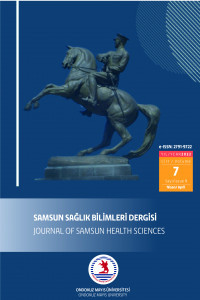ONDOKUZ MAYIS ÜNİVERSİTESİ BESLENME VE DİYETETİK BÖLÜMÜNDE OKUYAN ÖĞRENCİLERİN ORTOREKSİYA NERVOZAYA EĞİLİMLERİNİN BELİRLENMESİ
beslenme ve diyet bölümü, ortoreksiya nervoza, orto15, yeme bozukluğu
Determination of the Trends of Orthorexia Nervosa Students Nutrition and Dietetics Department Ondokuz Mayıs University
___
- Abayomi, J.C, Kolka, M. (2012). Body image dissatisfaction among food-related degree students. Nutrition & Food Science, 3(42):139-147.
- Alvarenga, M. S., Martins, M. C., Sato, K. S., Vargas, S. V., Philippi, S. T., Scagliusi, F. B. (2012). Orthorexia nervosa behavior in a sample of Brazilian dietitians assessed by the Portuguese version of ORTO-15. Eating and weight disorders : EWD, 17(1):29–35.
- Asil. E., Sürücüoğlu, M.S. (2015): Orthorexia Nervosa in Turkish Dietitians, Ecology of Food and Nutrition,54(4):1-11.
- Bağcı, Bosi, A.T., Çamur, D., Çağatay, G.(2007). Prevalence of Orthorexia Nervosa in Resident Medical Doctors in the Faculty of Medicine in Ankara, Turkey, Appetite, 49: 661-666.
- Barthels, F., Meyer, F., Pietrowsky, R. (2015). Orthorexic eating behavior. A new type of disordered eating. Ernahrungs Umschau 62(10): 156–161.
- Bratman, S., Knight, D.(2000). Health Food Junkies: Overcoming the Obsession with Healthful Eating. Broadway Books, New York ,1-242.
- Brytek-Matera, A., Donini. L.M, Krupa. M., Poggiogalle. E., Hay,P.,( 2015). Orthorexia Nervosa and Self-Attitudinal Aspects of Body Image in Female and Male University Students. Journal of Eating Disorders, 3: 2-2.
- Costa, C. B., Hardan-Khalil, K., Gibbs, K.,(2017). Orthorexia Nervosa: A Review of the Literature. Issues in mental health nursing, 38(12): 980–988.
- Donini, L.M, Marsili, D., Graziani, M.P., Imbrialle, Canella, C.,(2004). Orthorexia Nervosa: A Preliminary Study with a Proposal for Diagnosis and an Attempt to Measure the Dimension on the Phenomenon, Eating and Weight Disorders, 9: 151-157.
- Donini,L.M, Marsili, D, Graziani,M.P, Imbriale, M., Canella, C.,(2005). Orthorexia nervosa: a preliminary study with a proposal for diagnosis and an attempt to measure the dimension of the phenomenon, Eating and Weight Disorders,9(2):7-151.
- Garipoğlu, G., Arslan, M., Öztürk, A.S., (2019). Beslenme ve Diyetetik Bölümü'nde Okuyan Kız Öğrencilerin Ortoreksiya Nervoza Eğilimlerinin Belirlenmesi. İstanbul Sabahattin Zaim Üniversitesi Fen Bilimleri Enstitüsü Dergisi,1(3):23-27.
- Gezer, C.,Kabaran, S.,(2013). Beslenme ve Diyetetik Bölümü Kız Öğrencileri Arasında Görülen Ortoreksiya Nervoza Riski, S.D.Ü. Sağlık Bilimleri Dergisi,4(1):14-22.
- Harris, C.(2015) : Changes in Intuitive Eating and Orthorexia Scores among Female Graduate Students in Dietetics,115(9):30.
- Hauer, K., Kiefer, I., Kinzl, J.F., Traweger, C.(2006). Orthorexia Nervosa in Dieticians. Psychother Psychosom,75, 395-396.
- Hocaoğlu, Ç., Toker, D.E. (2009). Yeme Bozuklukları ve Aile Yapısı: Bir Gözden Geçirme. Düşünen Adam, 22(1-4):36-42.
- Karakus, B., Hidiroglu, S., Keskin, N., Karavus, M. (2017). Orthorexia nervosa tendency among students of the department of nutrition and dietetics at a university in Istanbul. North Clin Istanb.,4 (2):117–123
- Kazkondu, İ.,(2010). Üniversite Öğrencilerinde Ortoreksiya Nervoza (Sağlıklı Beslenme Takıntısı) Belirtilerinin İncelenmesi. Gazi Üniversitesi, Eğitim Bilimleri Enstitüsü, Aile Ekonomisi ve Beslenme Eğitimi Anabilim Dalı, Yüksek lisans tezi, Ankara, 95.
- Korinth, A., Schiess, S., Westenhoefer, J.(2010). Eating behaviour and eating disorders in students of nutrition sciences. Public Health Nutr.,13: 32-37.
- Koven, N. S., Abry, A. W. (2015). The clinical basis of orthorexia nervosa: emerging perspectives. Neuropsychiatric disease and treatment, 11:385–394.
- Meister, S.E.,(2010). The Occurrence of Highly Sensitive Attitudes and Behaviors Toward Eating among Undergraduate Students at a Midwestern University. M.S. thesis, Northern Illinois University, DeKalb County, Illinois, 150.
- Missbach, B., Barthels, F.(2017) Orthorexia Nervosa: moving forward in the field. Eat Weight Disord.;22(1):1.
- Okumuşoğlu, S. (2017). The relationship of orthorexic tendencies with eating disorder tendencies and gender in a group of university students. Curr Res Educ, 3(3):105-115.
- Poínhos, R., Alves, D., Vieira, E., Pinhão, S., Oliveira, B.M., Correia, F. (2015): Eating behaviour among undergraduate students. Comparing nutrition students with other courses. Appetite, 84:28-33.
- Ramacciotti, C.E, Perrone, P., Coli, E.(2011) : Orthorexia nervosa in the general population: a preliminary screening using a self-administered questionnaire (ORTO-15). Eat Weight Disord. 16(2):30-127.
- Rikani, A. A., Choudhry, Z., Choudhry, A. M., Ikram, H., Asghar, M. W., Kajal, D., Waheed, A., & Mobassarah, N. J. (2013). A critique of the literature on etiology of eating disorders. Annals of neurosciences, 20(4):157–161.
- Qian, J., Hu. Q., Wan, Y. (2013) : Prevalence of eating disorders in the general population: a systematic review. Shanghai Arch Psychiatry ;25(4):212-223.
- Valera, J.H.; Ruiz, P.A.; Valdespino, B.R.; Visioli, F.(2014). Prevalence of orthorexia nervosa among ashtanga yoga practitioners: A pilot study. Eat. Weight Disord., 19: 469–472.
- Yayın Aralığı: Yılda 3 Sayı
- Başlangıç: 2021
- Yayıncı: Ondokuz Mayıs Üniversitesi
Özge İŞERİ, Belgin ŞEN ATASAYAR
HEMŞİRELERDE DUYGUSAL EMEK DAVRANIŞI VE ETKİLEYEN FAKTÖRLER: KAMU HASTANELERİ ÖRNEĞİ
Yaşar DEMİR, Pınar ORUÇ, Yusuf Alper BAŞTÜRK, Saliha ÖZPINAR
EBELERİN TIBBİ HATA TUTUMLARI VE ETKİLEYEN FAKTÖRLER
Esra GÜNEY, Esra KARATAŞ OKYAY, Tuba UÇAR
EBELİK LİSANS ÖĞRENCİLERİNİN DUYGUSAL ZEKÂ VE İLETİŞİM BECERİLERİ ARASINDAKİ İLİŞKİNİN İNCELENMESİ
Neşe KARAKAYA, Serap TOPATAN, Nuran MUMCU, Emine KOÇ, Bahar ŞAHİN, Elif YAMAN
Nihal ÜNALDI BAYDIN, Esra TURAL BÜYÜK, Büşra PAZARLI
SALMONELLA BAKTERİSİNİN GIDALARDA VARLIĞI
HEMŞİRELİK ÖĞRENCİLERİNİN DİYABET VE İNSÜLİN UYGULAMALARINA İLİŞKİN BİLGİ DÜZEYLERİNİN BELİRLENMESİ
Şeyma YILDIRIM TOGLUK, Mehtap KAVURMACI
ÜNİVERSİTE ÖĞRENCİLERİNİN SAĞLIKLI YAŞAM DAVRANIŞLARI VE RUHSAL SAĞLIK DURUMU ARASINDAKİ İLİŞKİ
Ayşe ÇALMAZ, Gülay YILMAZEL, Birsen ALTAY
EVDE BAKIM VERİCİLERİN BAKIM VERMEDEKİ YETERLİLİK DÜZEYLERİ İLE BAKIM YÜKLERİNİN KARŞILAŞTIRILMASI
